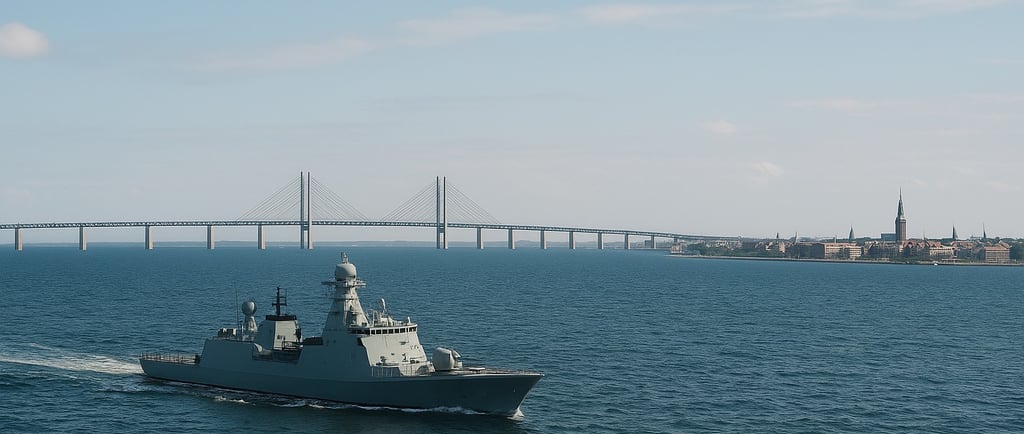The Danish straits: a strategic maritime gateway at the heart of European security
EUROPE
Thomas Dos Remedios
9/6/20254 min read


A STRATEGIC GATEWAY BETWEEN THE NORTH SEA AND THE BALTIC SEA
The Danish straits, comprising the Skagerrak, Kattegat and Øresund, are one of the most strategic maritime corridors in Northern Europe. These narrow passages connect the North Sea to the Baltic Sea and, by extension, the Atlantic to several key Baltic ports such as Gdansk, Riga and Tallinn. The Skagerrak, 58 nautical miles (approximately 107 km) wide, separates Denmark from Norway and is the main passageway for ships coming from the north. The Kattegat, 12 nautical miles wide (approximately 22 km), connects the Skagerrak to the Øresund and separates Swedish Jutland from the Danish peninsula. The Øresund, the narrowest of the straits, is only 4 km wide between Helsingør and Helsingborg, making it an extremely controllable and strategic passage.
Historically, these straits have always been at the centre of military and commercial interests. As early as the Middle Ages, Denmark saw the passages as a means of controlling trade in the Baltic, levying the famous ‘Øresund toll’ (strait toll), which brought the Danish Crown up to 30% of the kingdom's annual revenue. Today, around 70,000 ships pass through these straits every year, a significant proportion of which are oil tankers and heavy-tonnage merchant ships. This concentration of traffic makes control of these straits crucial to European security, as any major disruption could have immediate economic consequences for intra-European and global trade.
TRADE AND ENERGY FLOWS VITAL TO EUROPE
The Danish straits are not only essential for the movement of goods, but also for Europe's energy security. They allow ships carrying oil, liquefied natural gas (LNG), coal and chemicals to pass through to Baltic and Scandinavian ports. Trade passing through these straits accounts for a significant share of intra-European trade. For example, the port of Gdansk in Poland handled nearly 55 million tonnes of goods in 2023, 40% of which passed through the Danish straits.
In terms of energy, these passages are critical. The Baltic Pipe project, completed in 2022, connected Norway to Poland via Denmark, with a transport capacity of 10 billion cubic metres of gas per year, ensuring diversification of sources and reducing dependence on Russian gas. In addition, these straits are also used to transport oil cargoes from Norway and refined products transiting to German and Scandinavian ports. Dependence on these corridors for energy flows makes the straits a nerve centre, where any disruption, whether natural, accidental or strategic, could have an impact on energy prices throughout Europe.
Furthermore, the economic importance is not limited to oil and gas. The Danish straits are also essential for the transport of manufactured goods and strategic raw materials such as Swedish iron ore, which is transported via the Kattegat to German and Belgian steelworks. This logistical dimension makes securing these corridors a priority for the European Union, both for the economy and for the geopolitical stability of the region.
THE DANISH STRAITS : A MILITARY LOCK IN A RE-ARMED EUROPEAN CONTEXT
Contemporary geopolitics has repositioned the Danish straits at the centre of military concerns. The war in Ukraine, Sweden's accession to NATO in 2024 and the strengthening of the Russian fleet in the Baltic Sea have accentuated the strategic importance of these passages. The straits allow for the control of surface vessels and submarines, making any projection of power in the Baltic Sea dependent on control of these corridors.
NATO has increased its exercises and military presence in the region. Exercise Steadfast Defender 2024, the largest since the Cold War, mobilised 90,000 military personnel from 31 allied countries and Sweden to test the alliance's ability to rapidly reinforce Europe's eastern flank. This concentration of military activity highlights the strategic vulnerability of the straits and their role in deterring any attempt at maritime coercion.
Furthermore, the Danish straits are key maritime surveillance points. Control of naval traffic there is crucial for the security of the shipping lanes connecting the Baltic Sea to the Atlantic. In this context, Denmark, Sweden and Norway have developed sophisticated radar and sonar surveillance systems, as well as means of detecting drones and submarines, in order to ensure the security of these corridors.
CRITICAL INFRASTRUCTURE AND VULNERABILITIES TO HYBRID THREATS
Beyond commercial and energy transit, the Danish straits are home to critical infrastructure. Submarine telecommunications cables, gas pipelines and electrical interconnections are located there, forming the digital and energy backbone of the region. The attack on the Nord Stream gas pipeline in 2022 highlighted the vulnerability of this infrastructure, demonstrating that even facilities located in international waters can be the target of deliberate acts.
The Danish and Swedish authorities are actively monitoring the area, reporting incidents such as GPS jamming, the presence of underwater drones and suspicious movements around offshore wind turbines. This exposure to hybrid threats – cyberattacks, sabotage, espionage – requires close coordination between coastal countries and European institutions to secure critical flows and prevent any major disruptions that could affect trade and energy security in the region.
THE DANISH STRAITS : FROM MARITIME PERIPHERY TO STRATEGIC EUROPEAN HUB
Long considered peripheral, the Danish straits have established themselves as a strategic hub for Northern Europe. Their geographical position, combined with their role in trade, energy and military exchanges, makes them key locations for regional security. Controlling these straits means controlling access to the Baltic Sea and securing the economic, energy and digital flows of several European countries.
Cooperation between Denmark, Sweden, Norway, NATO and the European Union is now essential to maintaining stability in this area. These straits perfectly illustrate how historically secondary maritime corridors can become key strategic areas where economic, energy and military interests converge.
Thomas Dos Remedios, for SPECTIO
The statements made are solely those of their authors and do not reflect the position of the Think Tank Spectio.
